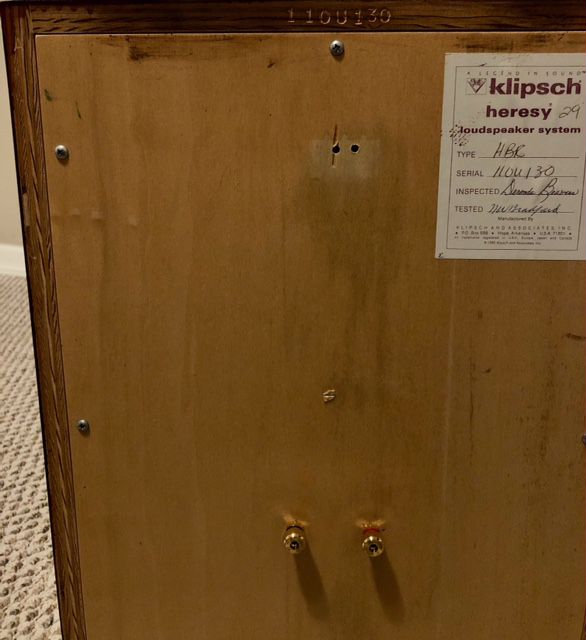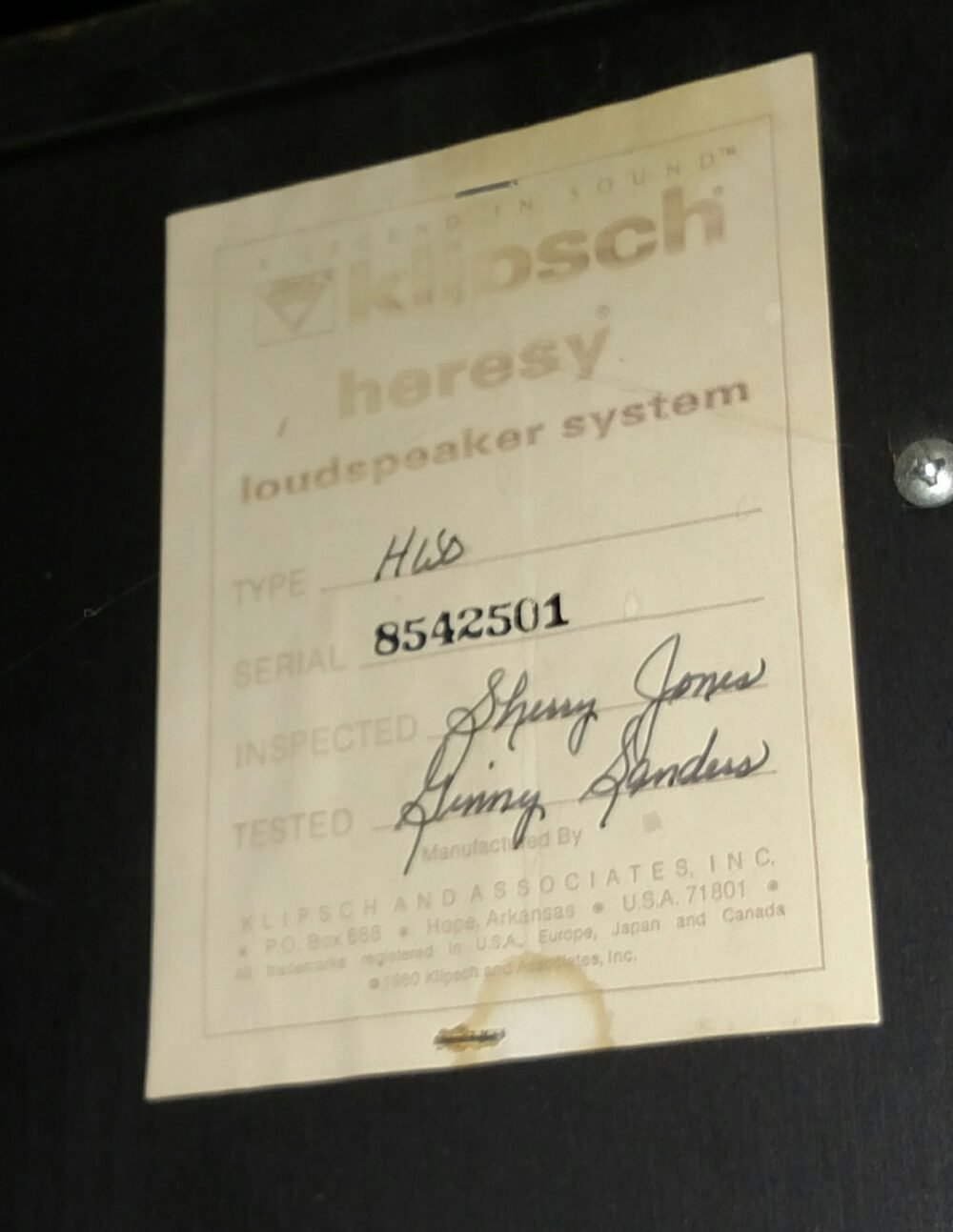
I'm looking at a pair of Klipsch Heresy locally. Described as 'Commercial' with a Mahogany Brown finish. Serial numbers are consecutive, 120W007 and 120W008. W = 1981 but not sure of the 120 prefix. Any help decoding the 120 prefix and what is unique to the 'Commercial' designation? Supernewhouston.bitballoon.com› ♥ ♥ ♥ Klipsch Serial Number Decoder ♥ ♥ ♥ This is a speaker build log with the intent of sharing information as well as acknowledging with respect, the fine work done by the late Paul Wilbur Klipsch.(March 9, 1904 – May 5, 2002) Paul was active in the company affairs up to age 96.
The Klipsch Forte is a three-way floor-standing speaker system that combines a vented direct-radiator woofer with horn-loaded compression drivers for the midrange and high frequencies. The 12-inch Klipsch-designed woofer has a 9-pound magnet structure, and its low-bass output is augmented by a 12-inch passive radiator.
The first crossover, at about 800 Hz, is to a midrange driver with mouth dimensions of 9 x 2-3/4 inches. At about 6,000 Hz there is a second crossover to a new Klipsch tweeter whose mouth is 4-5/8 inches wide and 2 inches high. According to the manufacturer, the tweeter has an exceptionally uniform beam-width and a smooth response extending to 20,000 Hz. The Forte, whose nominal impedance is 4 ohms, is a highly sensitive speaker rated to deliver a 96-dB sound-pressure level (SPL) at 1 meter with an input of 2.83 volts.


The woofer is located slightly above center in the speaker board, with the two horns directly above it and as close as their sizes permit. The low-frequency passive radiator, which externally resembles the driven woofer cone, is located on the rear panel directly behind the active driver. The system has no eternal level adjustments. Its binding-post terminals, on 3/4-inch centers, are recessed into the rear of the cabinet. The front is covered by a removable black grille cloth retained by snap fasteners. The Fort6 measures 35 inches high, 17 inches wide, and 12 inches deep, and it weighs 65 pounds. The cabinet is available in several choices of oil-finished wood veneers. Price: $1,100 per pair.
Lab Tests
The room response of the Klipsch Forte was one of the widest and smoothest we have ever measured, varying only ±2 dB from 230 to 20,000 Hz. The combined bass output of the driven and passive cones had a small peak at 45 Hz and another one, about 6 dB larger, at 150 Hz. This curve could be spliced easily to the room curve, producing a composite response curve varying only ± 5 dB from 40 to 20,000 Hz. Most of that variation was in the range of 40 to 200 Hz, where the response would be strongly affected by the room dimensions and placement of the speakers. The low-bass output of the Fort6 dropped rapidly below 40 Hz. The installation instructions note that the system's low-frequency cutoff is at 35 Hz and suggest using a low-cut filter in the amplifier to prevent overloading the speaker with infrasonic signal components.
Klipsch speakers have long been noted for their high sensitivity and low distortion, and the Fort6 follows in that tradition. Its measured output, driven by 2.83 volts of pink noise in an octave band centered at 1,000 Hz, was 95 dB SPL at 1 meter-one of the highest figures we have measured from a home speaker. To develop the 90-dB SPL that we use as a reference for bass-distortion measurements, an input of 1.6 volts was required.
The Forte's low-frequency distortion was by far the lowest we have ever measured from a speaker. Measured at the driven cone down to 50 Hz (the effective acoustic crossover to the passive cone) and at the passive cone below that frequency, the distortion was less than 0.2 percent from 100 to 50 Hz. It rose gently to a mere 1.5 percent at 23 Hz, which, because of the rapidly falling output of the system, was the lowest frequency for which we could make a measurement.
The system's minimum impedance was 4 ohms at 150 Hz, which was also the frequency of its maximum output. The impedance rose to a peak of 20 ohms at 65 Hz, then dropped back to 5 ohms at 42 Hz, rising again to about 19 ohms at 20 Hz. It reached an unusually high 130 ohms at 2,200 Hz, then descended to the range of 8 to 12 ohms between 6,000 and 20,000 Hz.
Quasi-anechoic FFT response measurements made at 45 degrees off-axis showed appreciable horizontal directivity over most of the audio range. At 30 degrees off-axis, however, the response was very close to the on-axis measurement over the full range of the speaker. These measurements underscored Klipsch's suggested placement for optimal stereo imaging, which is to aim the speakers inward toward the listeners so that they can 'look down the throat of each horn.' We followed this recommendation with very satisfactory results, although it did not appear to be a critical requirement.
The phase response of the Forte was good over the range of each of the high-frequency drivers, with an overall group-delay variation of 0.6 millisecond from 6,000 to 20,000 Hz and even less than that in the midrange band from 800 to 6,000 Hz. There was a distinct step in the group-delay measurement at 6,000 Hz. however, apparently caused by the different effective path lengths from the two horn-loaded drivers- approximately 2 inches and 9 inches for the high and midrange horns, respectively. The path-length differential of 7 inches corresponds closely to the measured group-delay difference of about 0.6 millisecond.

Our pulsed power-handling measurements produced a rattle from the woofer cone at 100 Hz with an input of 415 watts into the speaker's 6-ohm impedance. At 1,000 Hz, the amplifier's protection circuit tripped at about 715 watts into 19 ohms, before any waveform clipping could be seen. At 10,000 Hz the amplifier clipped while delivering some 1,300 watts to the tweeter's 10.5-ohm impedance! Given the high sensitivity of the Forte, these inputs correspond to truly prodigious sound-pressure levels.
Comments

Most of the speakers we test are at least competent performers. Each of them is usually average or slightly better in its price/size class in some respects and below the average in others. Even when the sound of a speaker is perfectly acceptable, and perhaps even especially enjoyable, it is difficult to make any dogmatic statements concerning its standing relative to its peers. But the Klipsch Forte is so outstanding in a number of its characteristics, and good or better in just about all the others, that we cannot pass it off as 'just another good speaker.' For one thing, it sounded even better than it measured.
Our initial impression of the Forte, before we made any measurements, was very favorable: superb overall octave-to-octave frequency balance, unusually wide extension of both low and high frequencies, and the absence of most of the usual speaker colorations (heavy midbass, sharp or dull highs, 'honkiness,' etc.). The sound had an open, airy quality that contributed markedly to our listening enjoyment.
We were disconcerted at first to hear a greater than usual hiss level on some FM programs. Was it possible that the speaker had a peaked high end? Not at all, as we found when playing CD's, which were reproduced with startling impact and not a hint of stridency. What we interpreted as a high-frequency emphasis was really due to the contrast between the Klipsch Forte and another system we had been listening to that has a somewhat soft (but nonetheless adequate) high-end response. As our measurements later proved, we were hearing a more accurate high-end response from the Forte than we have heard from most of the speakers to come our way in recent times.
Klipsch Heresy Serial Number Decoder Free
We also noted with interest-and approval-that Klipsch has not included user controls to alter the speaker's frequency balance. Our experience has been that designers of really fine speakers almost never give the user the option of degrading the response they have provided. And if controls are included, they should have only a very limited effect.
Klipsch Heresy Serial Number Decoder -
The Forte's bass response was riot as surprising-it is hard to imagine a Klipsch speaker being bass shy! Nonetheless, the bass seemed to reach downward beyond what we have usually experienced with other speakers. In this case it was the measurements that yielded unexpected results. It sounded as though the speaker might have reached to 30 or 35 Hz, but, by design, it simply won't get down to those depths. Yet the Forte is so potent in the region where there is real bass content in music, and it adds such a minute amount of bass distortion, that it gives the impression of generating an octave of bass beyond its true limit.
The installation instructions advise placing the speakers at least an inch from the back wall to let the passive radiators operate properly. Practical considerations required us to keep them about 2 feet from the wall, but this certainly did not impair their performance in any way. Because of the very high sensitivity of the Klipsch Forte, we were able to play the speakers as loudly as we wished from a moderately priced 60-watt receiver. Since the Forte is about 8 dB more sensitive than most home speakers, this combination can provide listening levels that would require 150 watts with the average speaker.
Klipsch Heresy Serial Number Decoder Online
It is not easy to be dispassionate about the Klipsch Forte. Its distortion and sensitivity measurements are so outstanding that comparison with most other speakers is impossible. In addition, these speakers just plain sound so good that we will hate to pack them up and send them back to Hope, Arkansas! In absolute terms, and especially at its price, the Forte would be hard to match, let alone surpass.